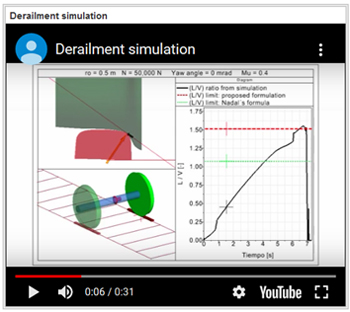Risk of derailment of railway vehicles
Derailment criteria based on the analysis of creep forces
Analysing in detail the lateral creep force that acts on a wheel in the moments prior to derailment, a new formulation for the estimation of the risk of derailment of a railway wheelset has been proposed. The new approach leads to derailment limits higher than those predicted by Nadal’s formula, particularly when the angle of attack of the wheelset is low. On the contrary, when the angle of attack increases, the new criteria converges to Nadal’s value, showing that the results obtained are consistent. The equations of the method can be implemented easily in a railway dynamics simulation package, and the computational cost is very low since most of the equations must be calculated only once at the beginning of the analysis. In addition, the new method takes into account parameters that are usually ignored but have influence on the derailment limit, like the rolling radius of the wheel or the normal force. For a detailed explanation of the method, click the publications tab.
A single wheelset moving along a straight track with a speed of V = 20 m/s is studied. An increasing lateral force is applied to the wheelset until derailment occurrs. The wheelset is forced to adopt a constant yaw angle during the whole simulation (zero yaw angle in this case), in order to compare results. In each integration step, the normal force is evaluated, and it is used to obtain the derailment limit.

In this video, a derailment simulation of a single wheelset made with SIMPACK is shown. On a straight track an increasing lateral force is applied to the wheelset until derailment occurs.

